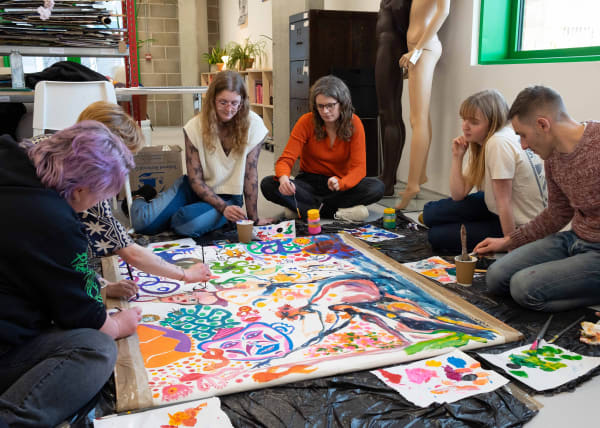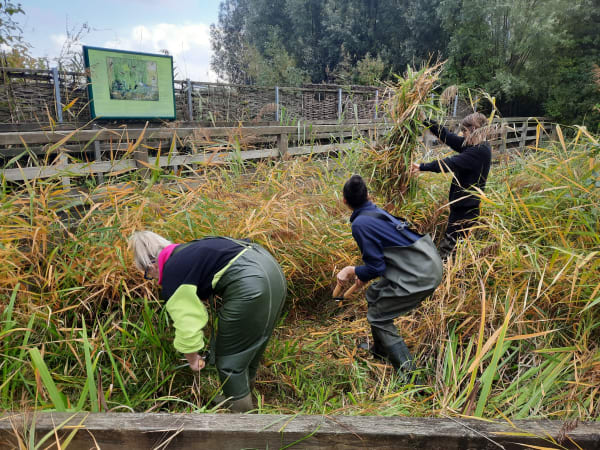-
One clear theme in response to the question ‘What else is made through making?’ during QUEERCIRCLE’s ‘Make Time’ sessions relates to curated safe spaces. Vulnerabilities are a common product of queer lived experience and, for some who visit, QUEERCIRCLE can represent a sanctuary of some kind. “Sanctuary is a good word for it – or dome, like the Eden Project ”
Participants with traumatic lived experience which they have successfully managed for years have taken advantage of a creative, facilitated space for revisiting difficult personal struggles, including to overcome the impacts of abuse and victimisation. In some ‘Make Time’ groups participants have felt safe enough to reflect on these experiences in the company of others, either verbally and collectively, or privately in their own thoughts. As artist and facilitator Terence Wilde writes: “We unpicked a great amount of shame in the studios at QUEERCIRCLE.” “I witnessed joy and pleasure on the faces of the embroiderers whilst they stitched away the darker things that did not serve them well anymore.”
Other projects in this exploration also demonstrated that QUEERCIRCLE participants were choosing to disclose or reflect on personal experiences of vulnerability – often related to their queer identity. In David Shenton’s ‘The Personal is Political ... or is it?’ participants were invited to place their experiences of ‘coming out’ at the heart of their cartoon drawing. Artist and facilitator David Shenton recalls that this felt risky: “All that comes up at the finale – you could end up with five or six who came up with very traumatic stories! We’re playing with dynamite really aren’t we?"
He highlighted the balance in any work of this kind – the point at which vulnerability and disclosure might cross a line and become unsafe for anyone in a creative workshop situation: “I felt I needed some sign-posting – ‘These are people you could go and speak to…” - David
When people open up about something in a workshop of this kind it is their choice, they could choose not to risk making themselves so vulnerable. Some participants in David’s session did choose less exposing stories to share – for example ‘coming out’ to a parent about a change of career – but it was interesting that so many people did share very personal, quite exposing or even traumatic coming out experiences, through the medium of cartoon illustrations.
-
So how was a safe (enough) space achieved?
The skills of the artist facilitator are central in creating a social dynamic within the workshop process that fosters this level of trust, and that can accommodate and support the needs of participants who take risks or make the decision to disclose vulnerabilities. QUEERCIRCLE has a growing network of queer-identified artists and creative facilitators, many of whom have extensive experience in shaping how a space or workshop feels – its ‘affective atmosphere’ or ‘vibe’.
The subtle and elusive idea of the ‘interactivity and interrelationship of space and emotions’¹ has been explored in literature for example by social geographer Ben Anderson². Anderson’s work, along with more recent research into how artists can facilitate change through their workshop practice³, explores how people can actively co-create or curate an atmosphere with specific qualities. My own doctoral study identifies artists as specifically skilled in producing and manipulating or ‘curating’ atmospheres in this way, and highlights this as a key artist facilitator skill in transformative creative processes. These feminist facilitation approaches, drawing on co-creation, collaboration and empathy – feeling ‘with’, seeing and hearing others’ experiences in a trusted group encounter – are certainly amongst the approaches QUEERCIRCLE artists commonly embrace (for example, those led by Ly Orrock and Becca Parkinson, and also, Lady Kitt).
In a different vein, facilitator George identified that the lightness – even ephemeral nature – of some of the workshops was what enabled a release for some participants: “I like this temporariness of workshops, think it’s really important, so (when things might be complicated in your day, or your life) you come in to the space for three hours, surrounded by people you’ve never met before, doing a process you’ve never done before, and after those three hours you never have to do it again... that temporariness allows people to open up, it just takes the pressure off it all...” -

-
Two extremely vulnerable young people in the group arrived appearing withdrawn and wearing noise reduction headphones. This was their first trip away from their ward, and their first time at QUEERCIRCLE. Quite soon after arriving both removed their headphones, and engaged gradually in more openly in the creative activities, suggesting that they were now reassured of the relative safety of the space for them.
They expressed identity-based slogans in their crafting/making, and their group became increasingly “giddy, loads of laughing”. By the end, fieldnotes from this session describe the group as “bouncing with its internal dynamic” (AR), certainly a contrast with how they presented on arrival.
-
So what does being in this safe (enough) space, and potentially exploring vulnerabilities through creative making, offer participants?
-
Along with any sense of achievement they might feel from having shared some creative time, and made or crafted something during the workshop, participants seemed to demonstrate specific emotional benefits. Field notes explore this in relation to one workshop:
“I feel that each person made themselves open and vulnerable through this activity, revealed something held tight and deep. And what is the impact of that experience? Well, there was a lot of support in people's responses, the vibe was truly tender, all barriers and senses of nervousness about status from the art skills angle seemed to drop away, as the crucial part of this communication was the message, not the skills shown. ... This was all about human fragility, and shared humanity.”
David observed in relation to the youngest participant in his workshop: “It was very moving to me that she drew what she’d been feeling for a few years – and I think she left the workshop a different person...” Feelings of bravery to embrace risk were experienced by participants in other projects: “Trips out to sew in cafes became extra-special moments, casting the safety net we made at QUEERCIRCLE further afield.” - Terence
The sense of social connection and mutual trust, discussed in a previous blog, is also deepened when the workshop encounter involves the risk and intensity of talking about difficult lived experience.
Drawing on all these findings about vulnerabilities, risk and shared, facilitated safe spaces for creative making, as witnessed in the ‘Make Time’ programme, it seems that QUEERCIRCLE may have the capacity to foster a unique kind of ‘space apart’ for participants. With the help of creative activities and secure facilitation, QUEERCIRCLE ‘Make Time’ participants have made time, and also found space, of a kind that has embraced and empowered them, and enabled them to embody a release from – as Terrence phrases it – ‘the things that don’t serve them’.
-
[1] Raw, A. (2013) 'A model and theory of community-based arts and health practice' p.329
[3] Anderson, B. (2009). Affective Atmospheres. Emotion, Space and Society, 2, 77-81
[4] Raw, A. (2013) as above; and Raw, A. (2014) Ethnographic Evidence of an Emerging Transnational Arts Practice? Perspectives on UK and Mexican Participatory Artists’ Processes for Catalysing Change and Facilitating Health and Flourishing. Anthropology in Action, 21(1), 13-2.




